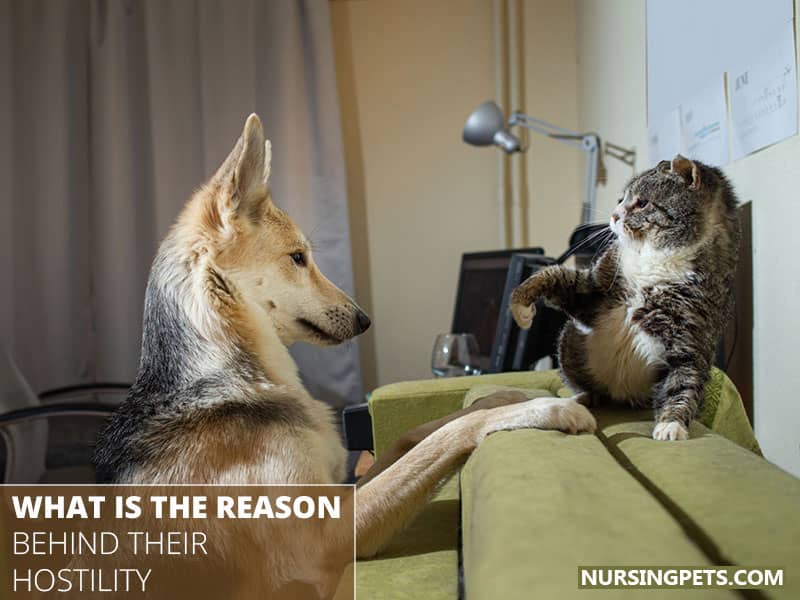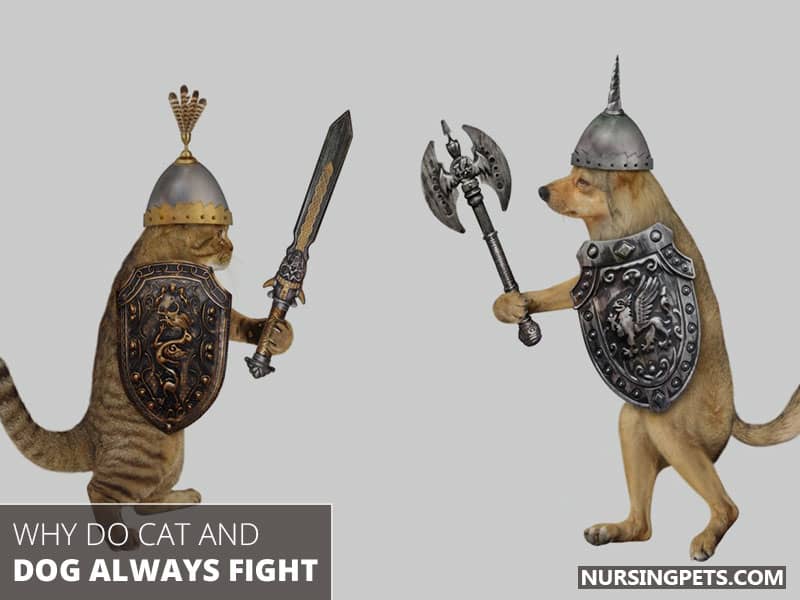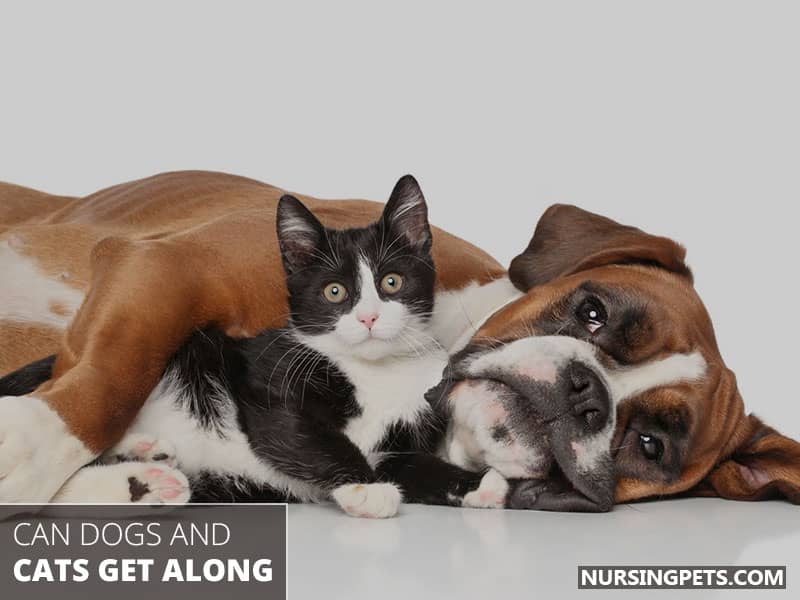10 Reasons Why Are Dogs And Cats Act Like Enemies?
It is common to observe that dogs and cats exhibit aggressive behavior towards each other, despite not being natural predators or prey. If you are a pet owner, you might have noticed your dog growling at your neighbor’s cat or your cat hissing at your family dog. This begs the question: why don’t dogs and cats like each other? Are they enemies?
Well, Cats and dogs have a natural predatory instinct. Cats typically escape from dogs, but some take defensive actions such as hissing, arching their backs, and swiping at the dog. And if a dog is scratched by a cat, it will usually become afraid of cats.
Moreover, cats and dogs are enemies because of their different personalities and training. These can also lead to conflict between the two species. However, we did know many people have petted cats and dogs at the same time. And both pets live together in harmony.
Regarding this question, we find out some interesting theories “why dogs and cats are enemies?” If you’re willing to know more about their motivation to fight each other, read the article until the end. Here is another article for you: why cats become aggressive at night.
Related Blog:
Reasons Why Do Cat And Dogs Always Fight?
We already know that dogs and cats aren’t natural enemies. So, what are the reasons for a fight between them? In their daggers-drawn relation, there are some interesting theories. And some of the most common reasons are listed below.

01. Lack of socialization: Socialization is crucial for both cats and dogs to learn how to interact with other animals and humans. If they don’t get enough exposure to other species, they may develop fear or aggression toward them.
Proper socialization should start at a young age, but even adult animals can benefit from gradual exposure to each other under supervision.
02. Prey drive: Both cats and dogs have a natural instinct to hunt and catch prey. When they see each other as potential prey, it can trigger a fight response. This is especially true for cats, who may feel threatened by a dog’s size and predatory behavior.
03. Territoriality: Cats and dogs are territorial animals, and they may become aggressive if they feel their territory is being invaded. This could include their home, yard, or even their favorite sleeping spot.
It’s important to make sure both animals have their own space and resources to avoid territorial conflicts.

04. Competition for resources: Cats and dogs can become possessive over resources such as food, water, and toys. If they feel like their resources are being threatened, it can lead to a fight.
So, it’s important to provide separate feeding and watering areas for each animal and to supervise playtime with toys.
05. Pain or illness: Animals that are in pain or feeling unwell may be more irritable and prone to aggression. It’s important to monitor your pets’ health and behavior and seek veterinary care if you notice any changes.
06. Panic: Fear is a powerful trigger for aggression, and both cats and dogs may attack if they feel threatened. It’s important to give animals space and time to adjust to each other and to avoid forcing interactions that make them uncomfortable.
07. Curiosity: Cats and dogs are naturally curious animals, and they may engage in play fighting to satisfy their curiosity. However, this can escalate into a full-blown fight if one animal becomes too rough or aggressive. It’s important to supervise playtime and intervene if necessary.
08. Lack of exercise: Both cats and dogs need regular exercise to release energy and reduce stress. If they don’t get enough exercise, they may become more irritable and prone to fighting. It’s important to provide opportunities for exercise and playtime, such as walks, play sessions, and puzzle toys.
09. Redirected aggression: Sometimes, an animal may become aggressive towards another animal due to a separate trigger, such as a person or another animal nearby.
This redirected aggression can result in a fight between the two animals. It’s important to avoid triggering situations and to separate the animals if necessary.
10. Predatory aggression: This type of aggression is more common in dogs, who may view cats as prey due to their small size and quick movements. It’s important to supervise interactions between cats and dogs, especially if the dog has a high prey drive.
Training and positive reinforcement can help to redirect this instinct towards appropriate activities.
Fighting between cats and dogs is often the result of one or more of the above factors. It is important to try and identify the trigger for the fighting to help prevent it from happening in the future. Ultimately, the reasons why cats and dogs fight are complex and could involve a variety of factors.
Are Cats Naturally Scared Of Dogs?
Yes, cats are naturally scared of dogs, and this is due to several reasons, including size disparity, instinctual behavior, and previous negative experiences. As most dogs are bigger than cats and smell like a predator, cats feel threatened and defenseless in their presence.
Furthermore, dogs have a natural instinct to chase fast-moving objects that are smaller than they are, which can be a scary experience for cats. Cats are timid by nature and have the instinct to flee and hide when they see a dog. And a dog can easily hurt or kill a cat.
Moreover, cats also tend to be afraid of dogs that are barking or growling, as this may indicate that the dog is about to chase or attack. However, the relationship between cats and dogs depends on individual experiences and socialization, and some cats may even view dogs as friends.
Why Do Cats Hit Dogs?
Cats always try to establish their dominance over dogs. In the wild, cats are the predators and often use physical aggression to establish dominance over other animals in their pack.

Domestic cats may view dogs as potential competitors or threats and try to assert dominance over them through physical aggression. Fear can also be a cause, as a cat may hit a dog as a way of defending itself.
Some cats may hit dogs simply because they are playing. Cats are very playful animals, and they may see the dog as a toy that they can play with. This type of behavior is usually not harmful to the dog, but it can be annoying.
Can Dogs and Cats Get Along?
There’s a debate among pet owners on whether dogs and cats can get along. Some people say they can be friends, while others believe it’s a recipe for disaster.
The truth is that it depends on the animals’ personalities, experiences, and training. When they’re both laid-back and docile, there’s a good chance they’ll get along.

However, whenever one of them is dominant and the other is timid, then there’s a greater chance of a clash.
In case you’re thinking about getting a dog and a cat, you need to do your research first. Watch how they interact with each other. If not, it might be best to choose one or the other.
What Are Some Ways To Get Dogs And Cats To Get Along?
When you’re a pet parent to a dog and a cat, you might wonder how to get them to get along. After all, you want your furry family members to be happy and healthy, and that means being able to coexist peacefully.
Luckily, you can do a few things to encourage a harmonious relationship between your dog and cat.
Here are some tips for getting dogs and cats to get along:
Introduce Them Gradually
When you first bring a new pet home, taking things slow is important. Introduce your dog and cat to each other gradually, giving them time to get used to each other’s smell and presence.
Keep Them Separated When You’re Not Home
You need to keep your dog and cat separated when you’re not home to supervise. This will help prevent any accidents or fights from happening. You can keep them in separate rooms or areas of the house with their beds, toys, and food.
Give Them Each Their Own Space
Just like people, dogs and cats need their own space. Make sure each pet has a safe place to retreat to if they feel overwhelmed or need a break from the other. This could be a crate or bed for your dog and a cat tree or perch for your cat.
Provide Plenty Of Toys And Playtime
Keeping your dog and cat entertained with their toys is a great way to help them get along. Make sure each pet has plenty of toys to keep them occupied, and set aside time each day for some fun playtime together.
Avoid Punishment
Punishing your dog or cat for fighting or arguing will only worsen the situation. It’s best to remain calm and positive when dealing with any disagreements between your pets.
Observe them closely. In case they do get into a physical altercation, simply separate them and try to redirect their attention to something else. With a little patience and effort, you can help your dog and cat get along and enjoy a happy, healthy relationship.
Can A Dog Bite Kill A Cat?
It is theoretically possible for a dog to kill a cat if it bites it hard enough. Dog bites can cause serious injuries to cats, including puncture wounds, lacerations, and broken bones. In some cases, a dog bite may even lead to death.

As a cat owner, it’s important to keep your dog properly restrained and supervised at all times to help prevent any accidents from happening.
Do Dogs Eat Cats?
Dogs do not normally eat cats. In most cases, dogs kill cats for sport rather than for food. But a dog can eat a cat, especially a kitten, given the opportunity.
Also, dogs are scavengers and will eat anything they come across that they think might be edible.
Kittens are natural prey for dogs, making them an easy target. While it’s not common for dogs to actively seek out kittens to eat, they will not hesitate to consume a cat if they have to.
For an issue between your cat and dog, keeping your dog secured in a fenced-in yard or indoors when you are not home to watch them is a good decision. This will help to ensure that your cat is safe from being eaten by your dog.
How Do I Stop My Dog From Attacking Cats?
It’s not uncommon for dogs to pursue and even attack cats. While some dogs have a strong prey drive and will run after anything that moves, others may only go after cats because they perceive them as a threat.
There are a few things you can do to stop your dog from attacking cats:
Keep them on a leash: This will allow you to keep control of your dog and prevent them from chasing after cats.
Train them to “leave it.”: This command will teach your dog to stop what they’re doing and walk away from the cat.
Use positive reinforcement: Whenever your dog sees a cat and doesn’t chase it, give them a treat or praise them. This will help them associate good things with not chasing cats.
Be consistent: It’s important to be consistent with your commands and rewards so that your dog knows what they’re supposed to do.
Seek professional help: If you’ve tried everything and your dog still seems intent on chasing and attacking cats, it may be best to seek help from a professional trainer or behaviorist.
Wrapping Up
There are many theories as to why dogs and cats are enemies. Dogs and cats have different personalities, training, or experiences. So, whatever the reason, the fact remains that some dogs and cats do not get along and are likely to fight when they are left together.
By the way, we hope you have learned a lot about why dogs and cats are considered enemies. If you still have any queries regarding this matter, comment down below. Keep in touch with us on Twitter, and Pinterest.

